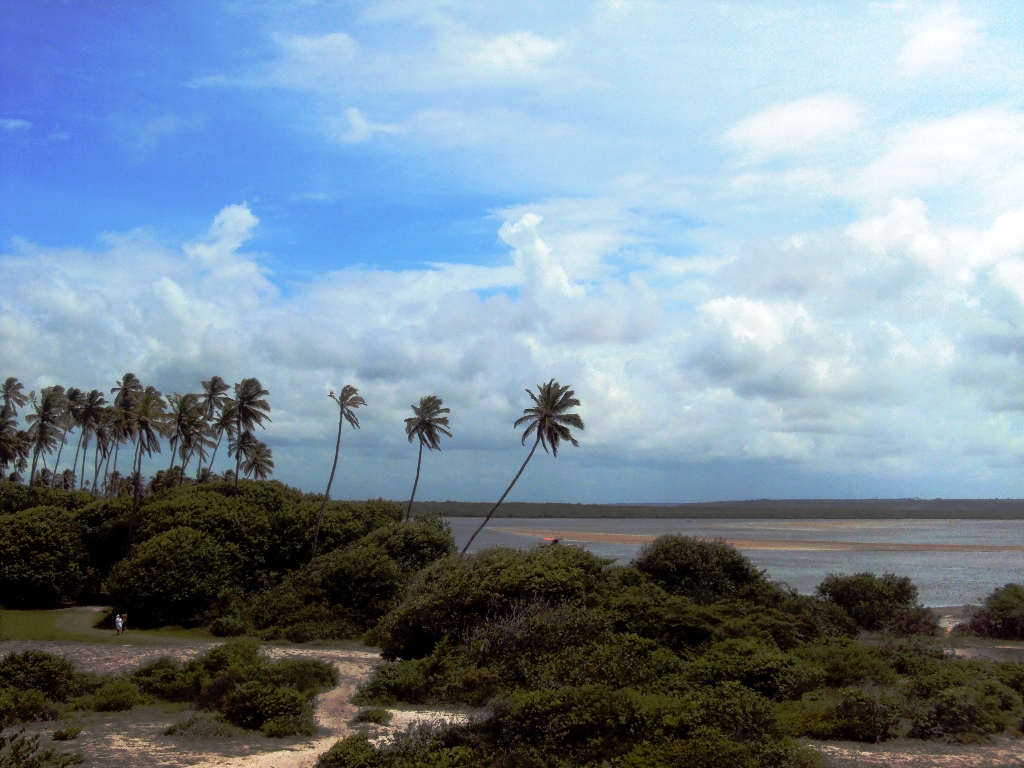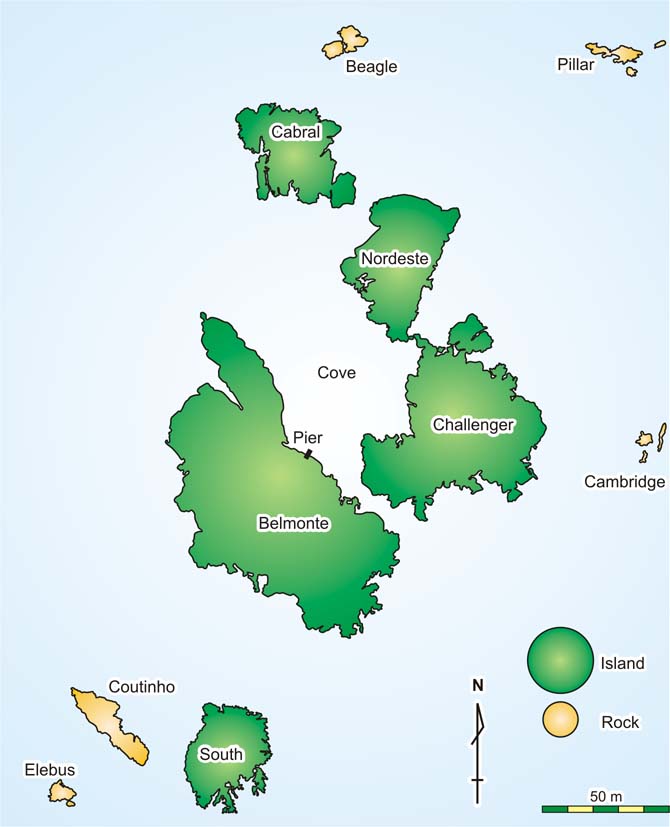|
Fernando De Noronha Environmental Protection Area
Fernando de Noronha Environmental Protection Area ( pt, Área de Proteção Ambiental Fernando de Noronha - Rocas - São Pedro e São Paulo) is a protected area on the island of Fernando de Noronha in the Atlantic ocean offshore from Pernambuco state, Brazil. Location The protected area, which covers of coastal marine land, was established on 5 June 1986. It is administered by the Chico Mendes Institute for Biodiversity Conservation. The reserve is part of the Fernando de Noronha municipality of Pernambuco state. The area covers the urban part of the island of Fernando de Noronha, while the Fernando de Noronha National Park covers the rest. The area includes a large marine extension to the Saint Peter and Saint Paul Archipelago, which is also in the National Park. Environment Much of the original vegetation of the island was cut when it was used as a prison, to make it harder for prisoners to hide. After that non-native species, particularly flaxseed, were introduced to feed liv ... [...More Info...] [...Related Items...] OR: [Wikipedia] [Google] [Baidu] |
Environmental Protection Area (Brazil)
An environmental protection area ( pt, Área de proteção ambiental: APA) is a type of protected area in Brazil that has some degree of human occupation, but where the primary intent is environmental protection. Human occupation is monitored and controlled. An environmental protection area often contains other types of conservation units, which may be more strictly protected. Definition Environmental protection areas (APAs) are defined as part of the National System of Conservation Units regulated by Law 9985 of 18 July 2000. They are one of the types of sustainable use units, which try to reconcile conservation of nature with sustainable use of some natural resources. Other types of sustainable use unit are significant ecological interest area, national forest, extractive reserve, fauna reserve, sustainable development reserve, and natural heritage particular reserve. As of 1993 APAs were defined as areas where wildlife, genetic diversity and other natural resources were to be ... [...More Info...] [...Related Items...] OR: [Wikipedia] [Google] [Baidu] |
Fernando De Noronha
Fernando de Noronha () is an archipelago in the Atlantic Ocean, part of the State of Pernambuco, Brazil, and located off the Brazilian coast. It consists of 21 islands and islets, extending over an area of . Only the eponymous main island is inhabited; it has an area of and a population estimated at 3,101 in 2020. While the archipelago is relatively low-lying, there are parts stretching above in elevation. The islands are administratively unique in Brazil. They form a "state district" ( pt, distrito estadual) that is administered directly by the government of the state of Pernambuco (despite being closer to the state of Rio Grande do Norte). The state district's jurisdiction also includes the very remote Saint Peter and Saint Paul Archipelago, located northeast of Fernando de Noronha. Seventy percent of the islands' area was established in 1988 as a national marine park. In 2001, UNESCO designated it as a World Heritage Site because of its importance as a feeding ground for t ... [...More Info...] [...Related Items...] OR: [Wikipedia] [Google] [Baidu] |
Pernambuco
Pernambuco () is a state of Brazil, located in the Northeast region of the country. With an estimated population of 9.6 million people as of 2020, making it seventh-most populous state of Brazil and with around 98,148 km², being the 19th-largest in area among federative units of the country, it is the sixth-most densely populated with around 89 people per km². Its capital and largest city, Recife, is one of the most important economic and urban hubs in the country. Based on 2019 estimates, the Recife Metropolitan Region is seventh-most populous in the country, and the second-largest in northeastern Brazil. In 2015, the state had 4.6% of the national population and produced 2.8% of the national gross domestic product (GDP). The contemporary state inherits its name from the Captaincy of Pernambuco, established in 1534. The region was originally inhabited by Tupi-Guarani-speaking peoples. European colonization began in the 16th century, under mostly Portuguese rule in ... [...More Info...] [...Related Items...] OR: [Wikipedia] [Google] [Baidu] |
Chico Mendes Institute For Biodiversity Conservation
The Chico Mendes Institute for Biodiversity Conservation (Portuguese: ''Instituto Chico Mendes de Conservação da Biodiversidade'', ICMBio) is the Brazilian Ministry of the Environment's administrative arm."Brazilian Federal Law 11.516/2007 (Portuguese)". http://www.planalto.gov.br/ccivil_03/_ato2007-2010/2007/lei/l11516.htm It is named after the environmental activist Chico Mendes Francisco Alves Mendes Filho, better known as Chico Mendes (; 15 December 1944 – 22 December 1988), was a Brazilian rubber tapper, trade union leader and environmentalist. He fought to preserve the Amazon rainforest, and advocated for the h .... References Nature conservation in Brazil Executive branch of Brazil Research institutes in Brazil Biodiversity databases Government agencies established in 2007 Environmental organizations established in 2007 2007 establishments in Brazil {{brazil-gov-stub, date=March 2014 ... [...More Info...] [...Related Items...] OR: [Wikipedia] [Google] [Baidu] |
Fernando De Noronha National Park
Fernando de Noronha Marine National Park ( pt, Parque Nacional Marinho de Fernando de Noronha) is a national park in the state of Pernambuco, Brazil. Location The Fernando de Noronha Marine National Park covers part of the island of Fernando de Noronha, a municipality of Pernambuco. It has an area of . The Fernando de Noronha Environmental Protection Area covers the urban part of the island of Fernando de Noronha, while the Fernando de Noronha National Park covers the rest. The area includes a large marine extension to the Saint Peter and Saint Paul Archipelago, which is also in the National Park. Administration The Fernando de Noronha Marine National Park was created by federal decree 96.693 on September 14, 1988. It is administered by the Chico Mendes Institute for Biodiversity Conservation (ICMBio). The park is classified as IUCN protected area category II (national park). The objective is to preserve a natural ecosystem of great ecological relevance and scenic beauty, and to ... [...More Info...] [...Related Items...] OR: [Wikipedia] [Google] [Baidu] |
Saint Peter And Saint Paul Archipelago
The Saint Peter and Saint Paul Archipelago ( pt, Arquipélago de São Pedro e São Paulo ) is a group of 15 small islets and rocks in the central equatorial Atlantic Ocean.The scientific station of São Pedro and São Paulo Archipelago - Brazil Alvarez, Cristina E., Melo, Julio E., Mello, Roberto L. Retrieved on June 6, 2009. It lies in the Intertropical Convergence Zone, a region of the Atlantic characterized by low average winds punctuated with local thunderstorms. It lies approximately from the nearest point of mainland |
IUCN Protected Area Categories
IUCN protected area categories, or IUCN protected area management categories, are categories used to classify protected areas in a system developed by the International Union for Conservation of Nature (IUCN). The enlisting of such areas is part of a strategy being used toward the conservation of the world's natural environment and biodiversity. The IUCN has developed the protected area management categories system to define, record and classify the wide variety of specific aims and concerns when categorising protected areas and their objectives. This categorisation method is recognised on a global scale by national governments and international bodies such as the United Nations and the Convention on Biological Diversity. Categories Category Ia – strict nature reserve A strict nature reserve (IUCN Category Ia) is an area which is protected from all but light human use in order to protect its biodiversity and also possibly its geological/geomorphical features. These areas ... [...More Info...] [...Related Items...] OR: [Wikipedia] [Google] [Baidu] |
Green Sea Turtle
The green sea turtle (''Chelonia mydas''), also known as the green turtle, black (sea) turtle or Pacific green turtle, is a species of large sea turtle of the family Cheloniidae. It is the only species in the genus ''Chelonia''. Its range extends throughout tropical and subtropical seas around the world, with two distinct populations in the Atlantic and Pacific Oceans, but it is also found in the Indian Ocean. The common name refers to the usually green fat found beneath its carapace, not to the color of its carapace, which is olive to black. The dorsoventrally flattened body of ''C. mydas'' is covered by a large, teardrop-shaped carapace; it has a pair of large, paddle-like flippers. It is usually lightly colored, although in the eastern Pacific populations, parts of the carapace can be almost black. Unlike other members of its family, such as the hawksbill sea turtle, ''C. mydas'' is mostly herbivorous. The adults usually inhabit shallow lagoons, feeding mostly on various ... [...More Info...] [...Related Items...] OR: [Wikipedia] [Google] [Baidu] |
Bodianus Insularis
''Bodianus insularis'', the island hogfish, is a species of wrasse. It is found in the Eastern Atlantic Ocean The Atlantic Ocean is the second-largest of the world's five oceans, with an area of about . It covers approximately 20% of Earth's surface and about 29% of its water surface area. It is known to separate the " Old World" of Africa, Europe .... Size This species reaches a length of . References insularis Fish of the Atlantic Ocean Taxa named by Martin F. Gomon Taxa named by Roger Lubbock Fish described in 1980 {{Labridae-stub ... [...More Info...] [...Related Items...] OR: [Wikipedia] [Google] [Baidu] |
Anthias Salmopunctatus
''Choranthias salmopunctatus'', the salmon-spotted jewelfish, is a species of marine ray-finned fish in the family Serranidae, the groupers and sea bass. It is endemic to Brazil Brazil ( pt, Brasil; ), officially the Federative Republic of Brazil (Portuguese: ), is the largest country in both South America and Latin America. At and with over 217 million people, Brazil is the world's fifth-largest country by area ... where a small population of Anthias salmopunctatus have been spotted near St. Peter and St. Paul's archipelago. Upon resurfacing after a 30-year disappearance, this population of fish can now be found aggregating in relatively small groups. References Anthiinae Fish of Brazil Endemic fauna of Brazil Fish described in 1981 Taxonomy articles created by Polbot {{Serranidae-stub ... [...More Info...] [...Related Items...] OR: [Wikipedia] [Google] [Baidu] |
Prognathodes Obliquus
''Prognathodes obliquus'', the oblique butterflyfish is a species of marine ray-finned fish, a butterflyfish belonging to the family Chaetodontidae. It is endemic to St Paul Rocks in the southwestern Atlantic Ocean off Brazil. Destruction of its habitat by pollution, marine construction and pollution has rendered it vulnerable to extinct Extinction is the termination of a kind of organism or of a group of kinds (taxon), usually a species. The moment of extinction is generally considered to be the death of the last individual of the species, although the capacity to breed and ...ion. References Fauna of Brazil obliquus Endemic fauna of Brazil Taxa named by Roger Lubbock Taxa named by Alasdair James Edwards Fish described in 1980 Taxonomy articles created by Polbot {{Chaetodontidae-stub ... [...More Info...] [...Related Items...] OR: [Wikipedia] [Google] [Baidu] |




